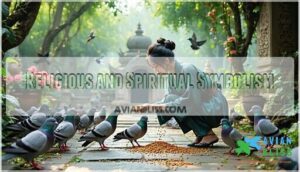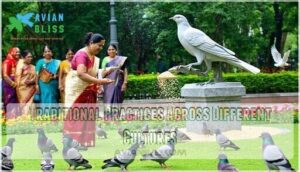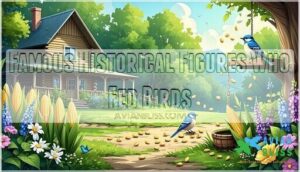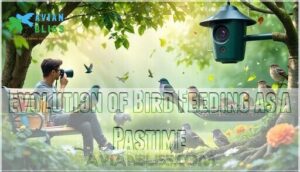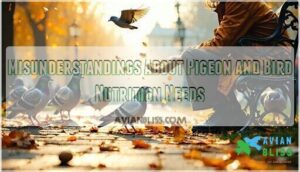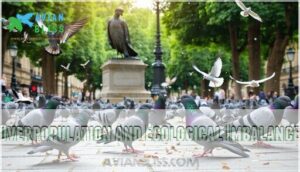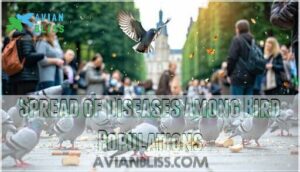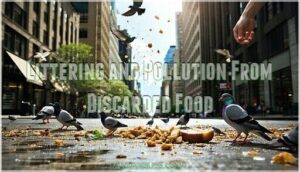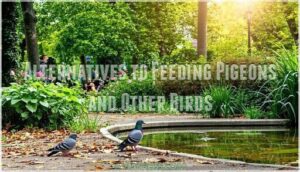This site is supported by our readers. We may earn a commission, at no cost to you, if you purchase through links.
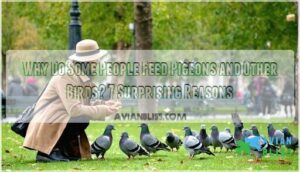
This connects you to cultural practices stretching back millennia—Egyptian beliefs about sacred messengers, Sikh spiritual traditions, and countless others.
Bird feeding builds community ties and fights urban isolation in ways most people don’t expect.
But there’s a flip side to this feel-good activity. When you regularly feed birds, you’re actually changing how they hunt for food naturally. They start depending on your handouts instead of searching for insects, seeds, and other wild foods.
This creates crowding around feeding spots, which spreads diseases faster between birds. Plus, some species multiply beyond what the local environment can handle. It’s one of those situations where good intentions create unexpected problems—and it says something interesting about how we balance our need to help with what’s actually helpful.
Table Of Contents
- Key Takeaways
- Psychological Benefits of Feeding Pigeons and Birds
- Cultural and Historical Significance of Bird Feeding
- Social Aspects of Feeding Pigeons in Urban Areas
- Misunderstandings About Pigeon and Bird Nutrition Needs
- Environmental Impact of Feeding Pigeons and Birds
- Alternatives to Feeding Pigeons and Other Birds
- Frequently Asked Questions (FAQs)
- Why do people eat pigeons?
- Should you feed pigeons?
- Why do people feed birds?
- How do you get pigeons to eat?
- What if they feed pigeons in another neighborhood?
- Why do pigeons keep coops?
- Why do some people feed pigeons?
- Why do homeless people feed pigeons?
- Why shouldn’t you feed pigeons?
- What is the significance of feeding pigeons?
Key Takeaways
- You’re feeding birds to meet deeper psychological needs like stress relief, connection with nature, and combating loneliness—research shows 65% of bird feeders use this as therapy.
- You’re participating in ancient cultural and spiritual traditions spanning thousands of years, from Egyptian sacred messenger beliefs to modern Sikh practices honoring compassion.
- You’re unintentionally disrupting natural ecosystems by creating food dependency, contributing to overpopulation, disease transmission, and attracting unwanted pests like rodents.
- You can help urban wildlife more sustainably by creating bird-friendly habitats with native plants, supporting conservation efforts, or joining citizen science monitoring projects instead of direct feeding.
Psychological Benefits of Feeding Pigeons and Birds
When you scatter breadcrumbs for pigeons, you’re not just feeding birds—you’re engaging in a behavior that research shows can markedly reduce stress hormones and promote emotional well-being.
Studies indicate that 65% of bird feeders use this activity as a form of therapy, finding that the simple act of nurturing these urban creatures creates measurable psychological benefits, including decreased anxiety and enhanced feelings of purpose.
Emotional Connection With Nature
Feeding pigeons touches your innate biophilia – that deep-seated love for living things. This Wildlife Bonding creates a genuine connection with nature, even in bustling cities. Here’s how Nature Therapy unfolds through bird feeding:
- Observing natural behaviors triggers Eco Awareness
- Green Spaces become personal sanctuaries
- Mindful Outdoors moments reduce daily stress
- Nature and Relaxation merge naturally
- connecting with nature becomes accessible anywhere
You’re fundamentally practicing nature therapy without realizing it.
Sense of Purpose and Responsibility
Animal care opens doors you didn’t know existed. When you feed local wildlife, you’re doing more than just scattering seeds—you’re joining a quiet network of people who care.
This kind of community service feels different from other volunteer work. It connects you to the rhythms of nature in ways that sitting behind a desk never could.
Every feeding becomes intentional eco stewardship. It’s a cultural practice that goes beyond simple kindness—you’re actively promoting animal welfare through thoughtful, responsible feeding.
Wildlife conservation work like this shapes who you become. Supporting these creatures isn’t just about helping pigeons; it’s about discovering what truly matters to you.
Stress Relief and Relaxation
Through connection with nature, you’ll discover powerful stress relief and relaxation. Research shows 65% of people use bird feeding as a therapeutic activity. Observing animal behavior creates mindful moments that naturally reduce cortisol levels and promote mental wellness.
- Calming activities like watching pigeons eat trigger your parasympathetic nervous system
- Therapeutic benefits emerge from rhythmic feeding motions and gentle bird sounds
- Inner peace develops through focused attention on wildlife conservation efforts
These relaxation techniques offer accessible pathways to tranquility.
Combating Loneliness and Social Isolation
You know that feeling when you’re in a crowded city but might as well be invisible? That’s urban isolation in a nutshell. Here’s something unexpected: feeding pigeons can actually break through that bubble.
You’ll find yourself chatting with other people who’ve discovered the same little ritual – maybe an elderly man who knows which birds have injuries, or a mom teaching her kid to be gentle with the bread crumbs. These aren’t life-changing conversations, but they’re real human moments that add up.
There’s something about watching birds that slows you down, gets you breathing again. Before you know it, you’re part of a loose community of people who nod hello at the same park bench.
Urban isolation hits harder when you’re surrounded by people yet feel completely alone. Feeding pigeons creates unexpected social connections through shared experiences with fellow bird enthusiasts. These human interactions at feeding spots combat mental health struggles while fostering community engagement. Connection with nature provides stress relief and inner peace, breaking isolation patterns.
| Social Benefit | Urban Impact | Mental Health Effect |
|---|---|---|
| Shared feeding experiences | Reduces anonymity | Decreases loneliness |
| Regular meeting spots | Creates micro-communities | Builds social confidence |
| Animal behavior discussions | Encourages conversation | Improves mood |
Feeling of Nurturing and Caregiving
Beyond simple bird feeding, you’re awakening deep nurturing instincts that fulfill your caregiving role. This emotional fulfillment mirrors parenting behaviors, offering therapeutic benefits through connecting with nature.
Studies show pigeon feeding triggers empathy responses, reducing stress while promoting personal growth. You’re fundamentally becoming a surrogate caregiver, satisfying that fundamental human need to nurture without long-term commitment. It’s nature’s way of letting you practice compassion daily.
Cultural and Historical Significance of Bird Feeding
You’re participating in a tradition that spans thousands of years across countless cultures worldwide.
From ancient Egyptians who considered birds sacred messengers to modern-day Sikh communities honoring Guru Gobind Singh through pigeon feeding, this behavior connects you to deep spiritual and cultural practices that have shaped human-bird relationships throughout history.
Religious and Spiritual Symbolism
Birds have served as sacred messengers across cultures for millennia. Many religious and astrological beliefs view these creatures as divine connection points between earth and heaven. When you feed pigeons, you’re participating in faith practices that span generations. Spiritual beliefs often frame this simple act as a way to nurture God’s creatures and invite blessings into your life.
Sacred rituals involving bird feeding appear in numerous traditions. Sikh communities honor Guru Gobind Singh through pigeon feeding. Hindu practices consider it beneficial for spiritual growth. Many astrologists believe feeding birds brings inner peace and happiness. The cultural significance of bird feeding extends beyond mere kindness—it’s viewed as a holy symbol of compassion.
Benefits of feeding pigeons include:
- Creating moments of quiet reflection and prayer
- Demonstrating reverence for all living beings
- Practicing mindfulness through gentle observation
- Building community bonds with fellow believers
- Expressing gratitude through acts of service
These pigeon feeding motivations reveal how ordinary moments become remarkable when viewed through spiritual eyes.
Traditional Practices Across Different Cultures
People have been feeding birds for thousands of years, and it shows how much different cultures value caring for these creatures.
Hindu communities have practiced "bhutayajna" – offering grains to birds daily – for over 3,500 years. Ancient Egyptians took it even further, setting aside whole fields just for sacred birds. Jain communities create public feeding stations as part of their commitment to nonviolence.
Traditional feeding practices reveal the cultural significance of nurturing birds across global societies. In Hindu traditions, "bhutayajna" involves daily grain offerings spanning 3,500 years, while Egyptian civilizations dedicated entire fields to sacred birds. Jain communities establish public feeding stations expressing nonviolence principles.
Religious and astrological beliefs drive pigeon feeding motivations in Nepal’s temple rituals. European folklore stories connect bird care to seasonal celebrations.
These historical roots demonstrate how global practices transform urban pigeon behavior, creating shared experiences that transcend cultural boundaries and strengthen community connections through simple acts of generosity. Understanding the bird feeding history provides valuable insights into the evolution of this practice.
Famous Historical Figures Who Fed Birds
You’ll find it fascinating that many Historic Bird Lovers shaped our understanding of bird feeding. These Famous Ornithologists didn’t just study birds—they actively supported their well-being through pigeon feeding and bird watching. Their dedication to Bird Conservation sparked a movement that continues today.
- Henry David Thoreau: Tossed half a bushel of unripe corn outside his cabin, attracting Blue Jays and Black-capped Chickadees
- John Freeman Dovaston: Created the ornithotrophe in 1825, a modified food trough that may be the origin of modern bird feeders
- Mabel Osgood Wright: An early Bird Conservation pioneer who made special bird food and wrote about it in "Birdcraft" (1896)
Evolution of Bird Feeding as a Pastime
Watch how bird feeding transformed from humble winter charity to a high-tech passion. Bird feeding has shifted from a mainly winter-only activity to a pastime commonly practiced year-round. In 1969, Droll Yankees created the first tube bird feeder, revolutionizing feeder innovations and Urban Birding trends.
Today’s Bird Watching Trends include smart feeders that photograph visitors and track Bird Feeding Benefits. This evolution reflects humanity’s deepening connection with Wildlife Conservation.
Modern backyard birding enthusiasts create Bird Friendly Gardens that sustain Wildlife Conservation Efforts year-round, making bird feeding a cornerstone of contemporary wildlife observation. The study of urban bird ecology provides valuable insights into the impact of bird feeding on local ecosystems.
Bird Feeding in Literature and Art
Artists have captured bird feeding’s magic for centuries. From Walt Disney’s beloved "Feed the Birds" – his favorite song – to impressionist paintings of garden scenes, these Literary Inspirations reveal deep Cultural Icons.
Creative Interpretations show bird feeding as acts of compassion and connection with urban wildlife. These Artistic Expressions highlight Bird Feeding Benefits beyond simple nutrition:
- Symbolic Meanings of charity and kindness through caring for vulnerable creatures
- Cultural touchstones that connect generations through shared Wildlife Conservation values
- Emotional bridges between humans and nature in busy urban environments
- Spiritual metaphors representing nurturing and bird watching as meditation
Social Aspects of Feeding Pigeons in Urban Areas
When you observe people feeding pigeons in city squares, you’re witnessing a fascinating social behavior that creates unexpected community bonds.
Research shows that pigeon feeding becomes a shared ritual where strangers connect over their common interest, transforming urban spaces into informal gathering spots where social interactions naturally occur.
Community Building and Shared Experiences
Most bird feeding creates social bonds through shared outdoor recreation. You’ll discover how backyard wildlife brings neighbors together in urban environments:
- Community engagement forms when residents exchange bird watching tips and human-wildlife interaction stories
- Cooperative learning develops as experienced feeders mentor newcomers about urban wildlife behaviors
- Neighborhood activities emerge around regular feeding schedules, creating natural gathering spots
This phenomenon transforms individual acts into collective experiences that strengthen social connections through nature.
Tourist Attractions and Local Landmarks
You’ve likely snapped photos at iconic feeders like St. Mark’s Square in Venice or Trafalgar Square in London. These urban birding hotspots draw millions yearly.
Tourist birdwatch experiences create memorable moments that define city wildlife encounters. Public spaces become urban environment showcases where visitors connect with urban wildlife.
Feeding pigeons transforms ordinary squares into iconic destinations. Bird feeding traditions shape the cultural identity of these famous locations worldwide.
Public Parks and Recreational Activities
Beyond famous tourist spots, your neighborhood park likely acts as a community hub for bird feeding activities. These recreational spaces witness fascinating community engagement behaviors where families bond over outdoor activities and recreation.
Park design influences how urban environments sustain wildlife management practices. Recreational visitors engage in bird feeding during public events, while urban greens provide natural gathering spaces. Urban wildlife management faces challenges balancing conservation with recreation.
- Children learning bird behavior through hands-on feeding experiences
- Elderly visitors establishing daily routines around bird interactions
- Amateur photographers documenting urban bird species diversity
- Park staff managing feeding guidelines for ecological balance
Homeless Individuals and Bird Feeding
You’ll notice homeless individuals sharing their limited food with pigeons across city streets. This behavior represents more than simple kindness—it’s Street Outreach through Bird Therapy. These interactions create Social Bonds and provide Urban Refuge for both humans and birds.
Community Aid networks often form around these feeding sites, where human-wildlife interaction becomes a source of comfort and purpose in challenging urban environments.
| Behavior | Observed Benefits |
|---|---|
| Daily feeding routine | Provides structure and responsibility |
| Pigeon companionship | Reduces social isolation |
| Shared food resources | Creates sense of nurturing despite scarcity |
Debates on Urban Wildlife Management
Feeding wildlife throws ecosystems out of whack and creates imbalances, but research on feeding’s environmental effects reveals messy, complicated results that call for thoughtful wildlife conservation strategies.
Wildlife feeding disturbs healthy ecosystems and skews the balance, yet Environmental Impact of Feeding research shows complex outcomes requiring nuanced Wildlife Conservation approaches.
- Officials banning feeding face accusations of heartlessness
- Restriction policies may actually increase covert feeding problems
- Ecosystem Services benefits clash with overpopulation concerns
- Participative management integrating feeders as co-carers shows promise
Misunderstandings About Pigeon and Bird Nutrition Needs
You probably think you’re helping when you toss bread crumbs to pigeons, but you’re actually creating nutritional problems that can harm their health.
Field studies show that well-meaning feeders often provide foods that lack essential nutrients or contain harmful ingredients, leading to malnutrition and weakened immune systems in urban bird populations.
Common Misconceptions About Bird Diets
You’ve probably heard that bread’s fine for birds, but bird nutrition experts know better. Most people think pigeons can eat anything, yet their dietary needs require specific seed types and nutrients.
Quality bird seed contains proteins and fats that white bread lacks completely. Feeding schedules don’t matter if you’re offering junk food that harms their avian diet long-term.
Harmful Effects of Human Food on Birds
That leftover sandwich you’re tossing? It’s not the treat birds need. Human food poses serious risks of bird feeding and wildlife conservation efforts suffer from our good intentions. Consider these Toxic Food Sources:
- Salt overload causes kidney failure and death in birds
- Chocolate contains theobromine, triggering fatal Food Poisoning and Avian Diseases
- Bread provides empty calories, leading to Bird Malnutrition
This Human Impact disrupts natural foraging behaviors essential for healthy human-wildlife interaction.
Proper Bird Feed and Nutritional Requirements
Understanding proper bird feed transforms your feathered friends from occasional visitors into healthy, thriving companions. Bird dietetics isn’t rocket science, but seed selection matters considerably. Black oil sunflower seeds remain the benchmark, while nyjer seeds attract finches like magnets. Suet provides essential fats during colder months.
- Nutrient balance: Mix seeds, grains, and proteins for complete nutrition
- Supplement safety: Avoid chocolate, avocado, and salted foods entirely
- Feeder maintenance: Clean birdseed stations weekly to prevent contamination
Quality birdseed and proper bird feeders guarantee your pigeon diet fosters natural behaviors while maintaining peak health.
Seasonal Variations in Bird Feeding Habits
Throughout the year, birds’ nutritional needs shift dramatically based on seasonal demands. During Winter Birding months, you’ll notice birds craving high-fat seeds and suet to maintain body heat. Spring Migration brings increased protein requirements as birds prepare for breeding season. Summer Feeding becomes less critical since natural food sources abound – insects, fruits, and seeds are everywhere. As Autumn Habitats prepare birds for winter, they’ll focus on storing energy through nutrient-dense birdseed.
These Seasonal Diets mean your bird feeders should adapt accordingly, offering appropriate Wildlife nutrition year-round.
Importance of Clean Water Sources
Fresh water isn’t just nice to have – it’s life or death for wild birds. Unlike seasonal feeding patterns, bird hydration needs stay consistent year-round. Wildlife needs Water Quality that won’t make them sick.
Here’s what makes water sources work:
- Clean Feeders prevent bacterial growth that spreads disease
- Fresh Sources changed daily keep birds healthy and coming back
- Aquatic Health promotes Conservation efforts in your backyard
Environmental Impact of Feeding Pigeons and Birds
Feeding breadcrumbs to pigeons seems harmless enough. But those scattered crumbs set off a chain reaction that reaches way beyond the birds pecking at your feet.
Your well-meaning gesture can disrupt natural foraging patterns and trigger overpopulation issues that affect entire urban ecosystems.
Your well-meaning gesture can disrupt natural foraging patterns and trigger overpopulation issues that affect entire urban ecosystems.
Disruption of Natural Foraging Behaviors
Birds naturally develop food dependency when you regularly feed them, losing essential foraging habits. This disrupts ecosystem dynamics and wildlife balance as birds stop seeking diverse food sources.
Natural behavior changes affect migration patterns and territorial boundaries. Bird feeding without understanding environmental impact alters bird behavior and ecology.
Responsible feeding means recognizing how human-wildlife interaction shifts survival instincts permanently.
Overpopulation and Ecological Imbalance
When abundance kicks in, nature’s delicate balance goes haywire. Your well-meaning generosity triggers Food Dependency among wild birds, creating unnatural population booms that strain urban ecosystems. Effective Population Control becomes vital as cities struggle to maintain Ecological Balance through Wildlife Management strategies. This human-wildlife interaction creates serious Conservation challenges:
- Native species face displacement as pigeons dominate limited resources
- Breeding competition intensifies when flock sizes exceed carrying capacities
- Habitat Destruction accelerates through increased waste and environmental impact on urban green spaces
Ecosystem Disruption follows quickly behind.
Spread of Diseases Among Bird Populations
When you gather feathered carriers in feeding spots, disease transmission becomes a real concern for bird health risks. Up to 49% of urban pigeons carry infectious diseases that spread rapidly through congregated flocks. Avian pathogens like H5N1 create wildlife epidemics, especially during migration seasons.
| Disease Type | Transmission Method |
|---|---|
| Avian Influenza | Contaminated surfaces, droppings |
| Salmonellosis | Shared feeding stations |
| Trichomonosis | Direct bird contact |
| Fungal infections | Spoiled food residues |
Attraction of Pests and Unwanted Wildlife
When you’re feeding pigeons, you’re basically rolling out the welcome mat for uninvited guests. Rats, mice, and other scavengers quickly discover these food sources, creating significant disease transmission risks and garden damage prevention challenges.
These unwelcome visitors disrupt ecosystem balance through their rapid reproduction and destructive behaviors. Effective urban wildlife management requires understanding these human-wildlife interaction consequences.
Pest control methods become necessary when bird feeding attracts rodent populations that threaten public health and property.
Littering and Pollution From Discarded Food
Beyond attracting pests, Feeding Pigeons creates another headache: Food Waste Management and Urban Pollution. Your well-meaning breadcrumbs become tomorrow’s litter problem. Discarded Food Impact extends far beyond messy sidewalks—it affects Environmental Conservation and human-wildlife interaction.
Here’s what happens with leftover food:
- Rotting scraps attract rodents and insects
- Environmental Impact of Bird Feeding includes contaminated water sources
- Cleanup costs burden city budgets and taxpayers
- Poor hygiene threatens both bird and human health
- Litter Reduction Strategies become necessary for community wellbeing
Smart Environmental Awareness means choosing designated feeding areas with proper cleanup protocols.
Alternatives to Feeding Pigeons and Other Birds
Worried that bird feeders might mess with natural habits? You’re not alone. Here’s the thing though – you can still help urban birds thrive without setting up a backyard buffet.
Planting native plants makes a real difference. Research backs this up too – creating actual habitat beats artificial feeding when it comes to supporting healthy bird populations long-term.
Research shows that planting native vegetation and participating in citizen science projects provide more sustainable ways to connect with birds while maintaining their natural foraging behaviors.
Creating Bird-friendly Habitats in Urban Areas
Creating bird-friendly habitats in urban areas offers a powerful alternative to traditional bird feeding while aiding wildlife conservation and human-wildlife interaction. Instead of creating dependency through direct feeding, cities can be transformed into thriving ecosystems through eco-friendly design and sustainable landscaping practices.
Consider these effective approaches to habitat preservation:
- Urban Green Spaces and rooftops: Green roofs provide critical nesting sites while protecting birds from predators and harsh weather conditions
- Designated Bird Sanctuary areas: Converting portions of urban parks into protected wildlife zones creates safe havens for diverse species
- Native plant gardens: Sustainable Urban Living includes planting indigenous species that naturally attract birds and provide year-round food sources
These conservation strategies foster natural foraging behaviors rather than artificial feeding dependencies, creating healthier urban ecosystems that benefit both wildlife and residents.
Promoting Natural Food Sources for Birds
Native plantings transform urban spaces into bird feeding sanctuaries. You’ll create bird-friendly gardens that sustain wild birds through sustainable birding practices.
These natural food sources encourage foraging behaviors while reducing dependency on traditional feeder systems. Urban wildlife conservation thrives when you plant berry-producing shrubs and seed-bearing flowers.
This approach sustains responsible bird feeding practices by letting nature provide the menu instead of artificial supplements.
Educational Programs on Responsible Bird Watching
Wildlife Education programs offer practical paths to responsible observation instead of direct Bird Feeding. These structured learning opportunities teach Bird Identification skills through hands-on workshops and field guides. You’ll discover how your actions affect local ecosystems while developing sustainable Backyard Bird Watching techniques.
- Learn species recognition through guided Nature Preservation walks
- Practice Responsible Bird Feeding Practices with expert mentors
- Join Project FeederWatch citizen science initiatives
- Connect with Eco Tourism groups for Bird Conservation adventures
Supporting Bird Conservation Efforts
Your conservation efforts create ripples that extend far beyond individual bird feeding experiences. Back local bird sanctuaries through volunteering or donations, helping establish sustainable habitats for wildlife preservation.
Choose eco-friendly conservation methods like native plant gardening to boost human-wildlife interaction. These actions boost the importance of bird feeding while creating lasting benefits for entire ecosystems.
Engaging in Citizen Science Bird Monitoring Projects
Beyond conservation efforts, you can become a real wildlife researcher through citizen science projects. Join Project FeederWatch or local bird surveys to collect valuable data on species populations and migration patterns.
Your backyard observations contribute to serious ornithology research and Wildlife Research initiatives. These Bird Surveys help scientists understand human-wildlife interaction effects from the Wild Bird Feeding Industry, making your Data Analysis skills part of Bird Conservation efforts nationwide.
Frequently Asked Questions (FAQs)
Why do people eat pigeons?
Like a time-worn recipe passed through generations, you’ve likely heard of squab—young pigeon enjoyed across cultures for millennia.
Ancient civilizations from Egypt to Rome have consumed these birds, finding them nutritious and readily available.
Should you feed pigeons?
You shouldn’t regularly feed pigeons. While it feels rewarding, feeding creates dependency, disrupts natural foraging behaviors, and can lead to overpopulation and disease transmission in urban environments.
Why do people feed birds?
What draws you to scatter breadcrumbs for feathered friends? You’re seeking connection, stress relief, and purpose.
Bird feeding offers therapeutic benefits, reduces anxiety, and creates meaningful community bonds while providing wildlife care opportunities.
How do you get pigeons to eat?
You’ll attract pigeons easily by scattering breadcrumbs, seeds, or grains on the ground. They’re opportunistic feeders who’ll quickly discover consistent food sources.
Start small and they’ll return regularly once they trust you’re reliable.
What if they feed pigeons in another neighborhood?
You’re creating a mobile pigeon population that follows food sources. They’ll adapt their foraging patterns to different neighborhoods, potentially reducing local bird diversity and increasing territorial conflicts between flocks.
Why do pigeons keep coops?
Pigeons don’t naturally keep coops – humans build these sheltered structures called lofts or aviaries for domesticated pigeons.
People create coops to provide controlled breeding environments, protection from predators, and safe nesting spaces for their pigeon flocks.
Why do some people feed pigeons?
Like tiny messengers of hope, you’ll find people feeding pigeons for psychological comfort and stress relief.
The ritual provides mindfulness, combats loneliness, and creates community connections while offering birds urban survival aid.
Why do homeless people feed pigeons?
You’ll find companionship through feeding birds when social connections are scarce. This gentle ritual provides purpose, structure, and nonjudgmental relationships that offer emotional comfort and temporary escape from urban hardships.
Why shouldn’t you feed pigeons?
You shouldn’t feed pigeons because it creates dependency, disrupts natural foraging behaviors, causes overpopulation, increases disease transmission risks, attracts pests like rodents, and leads to environmental pollution from food waste.
What is the significance of feeding pigeons?
Incredibly, you’re participating in a 4-billion-dollar industry that transforms urban landscapes into wildlife sanctuaries.
Feeding pigeons creates psychological benefits like stress reduction and community connection while honoring deep cultural traditions spanning centuries across diverse religious practices.
Ever wonder why people toss breadcrumbs to pigeons? It’s more complicated than you’d think. This simple gesture taps into something fundamental about human nature—our need to nurture, connect, and feel useful in the world.
Feeding pigeons satisfies our fundamental need to nurture and connect, transforming a simple act into profound psychological therapy
You’re not just feeding birds—you’re addressing loneliness, finding purpose, and participating in ancient traditions.
While your intentions are noble, consider alternative ways to help urban wildlife that don’t disrupt natural behaviors or create ecological imbalances.
While your intentions are noble, consider alternative ways to help urban wildlife that don’t disrupt natural behaviors or create ecological imbalances.
- https://www.techexplorist.com/new-spin-organic-semiconductors/21866/
- https://academic.oup.com/jue/article/7/1/juab018/6327593
- https://pmc.ncbi.nlm.nih.gov/articles/PMC7984256/
- https://www.channelnewsasia.com/singapore/pigeon-population-keep-growing-unless-people-stop-feeding-924686
- https://www.ovocontrol.com/pigeon-facts-figures

